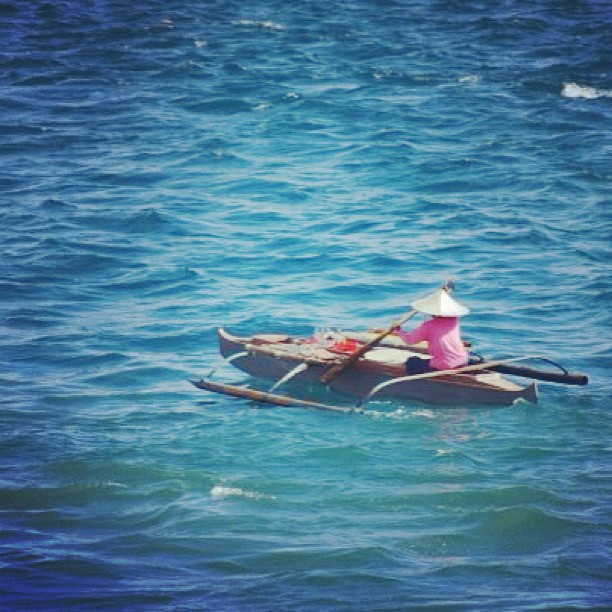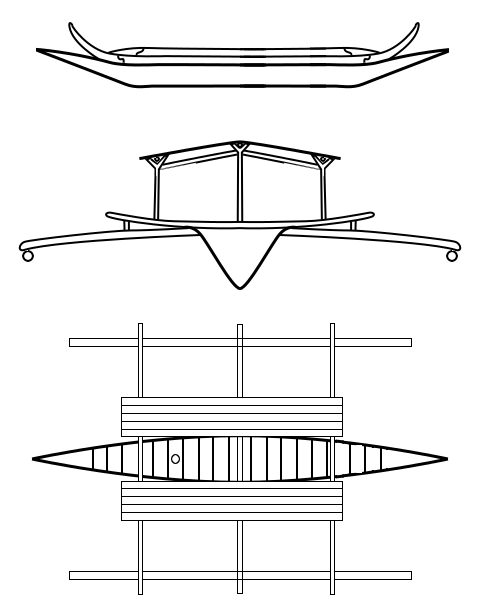|
Ontang
Ontang is a type of raft of the Sama-Bajau people of the Philippines. They resemble a miniature catamaran, with two bamboo floats about long connected by two bow-shaped booms. A platform made split bamboo is built on top of the booms. Ontang can be used for fishing, but they can also hold lanterns during night-time fishing. They are typically towed behind Sama-Bajau houseboats during travel, with the towing line commonly strung with baited fish hooks. See also * Junkun * Owong * Vinta * Djenging * Garay (ship) * Balangay References {{Fishing vessel topics Indigenous ships of the Philippines ... [...More Info...] [...Related Items...] OR: [Wikipedia] [Google] [Baidu] |
Raft
A raft is any flat structure for support or transportation over water. It is usually of basic design, characterized by the absence of a hull. Rafts are usually kept afloat by using any combination of buoyant materials such as wood, sealed barrels, or inflated air chambers (such as pontoons), and are typically not propelled by an engine. Rafts are an ancient mode of transport; naturally-occurring rafts such as entwined vegetation and pieces of wood have been used to traverse water since the dawn of humanity. Human-made rafts Traditional or primitive rafts were constructed of wood or reeds. Modern rafts may also use pontoons, drums, or extruded polystyrene Polystyrene (PS) is a synthetic polymer made from monomers of the aromatic hydrocarbon styrene. Polystyrene can be solid or foamed. General-purpose polystyrene is clear, hard, and brittle. It is an inexpensive resin per unit weight. It is a ... blocks. Inflatable rafts up to the 20th century used flotation chambers ... [...More Info...] [...Related Items...] OR: [Wikipedia] [Google] [Baidu] |
Sama-Bajau
The Sama-Bajau include several Austronesian ethnic groups of Maritime Southeast Asia. The name collectively refers to related people who usually call themselves the Sama or Samah (formally A'a Sama, "Sama people"); or are known by the exonym Bajau (, also spelled Badjao, Bajaw, Badjau, Badjaw, Bajo or Bayao). They usually live a seaborne lifestyle and use small wooden sailing vessels such as the ''perahu'' (''layag'' in Meranau), ''djenging'' (''balutu''), '' lepa'', and ''vinta'' (''pilang''). Some Sama-Bajau groups native to Sabah are also known for their traditional horse culture. The Sama-Bajau are the dominant ethnic group of the islands of Tawi-Tawi in the Philippines. They are also found in other islands of the Sulu Archipelago, coastal areas of Mindanao, northern and eastern Borneo, Sulawesi, and throughout the eastern Indonesian islands. In the Philippines, they are grouped with the religiously similar Moro people. Within the last fifty years, many of the Filipino ... [...More Info...] [...Related Items...] OR: [Wikipedia] [Google] [Baidu] |
Philippines
The Philippines (; fil, Pilipinas, links=no), officially the Republic of the Philippines ( fil, Republika ng Pilipinas, links=no), * bik, Republika kan Filipinas * ceb, Republika sa Pilipinas * cbk, República de Filipinas * hil, Republika sang Filipinas * ibg, Republika nat Filipinas * ilo, Republika ti Filipinas * ivv, Republika nu Filipinas * pam, Republika ning Filipinas * krj, Republika kang Pilipinas * mdh, Republika nu Pilipinas * mrw, Republika a Pilipinas * pag, Republika na Filipinas * xsb, Republika nin Pilipinas * sgd, Republika nan Pilipinas * tgl, Republika ng Pilipinas * tsg, Republika sin Pilipinas * war, Republika han Pilipinas * yka, Republika si Pilipinas In the recognized optional languages of the Philippines: * es, República de las Filipinas * ar, جمهورية الفلبين, Jumhūriyyat al-Filibbīn is an archipelagic country in Southeast Asia. It is situated in the western Pacific Ocean and consists of around 7,641 islands t ... [...More Info...] [...Related Items...] OR: [Wikipedia] [Google] [Baidu] |
Catamaran
A Formula 16 beachable catamaran Powered catamaran passenger ferry at Salem, Massachusetts, United States A catamaran () (informally, a "cat") is a multi-hulled watercraft featuring two parallel hulls of equal size. It is a geometry-stabilized craft, deriving its stability from its wide beam, rather than from a ballasted keel as with a monohull boat. Catamarans typically have less hull volume, smaller displacement, and shallower draft (draught) than monohulls of comparable length. The two hulls combined also often have a smaller hydrodynamic resistance than comparable monohulls, requiring less propulsive power from either sails or motors. The catamaran's wider stance on the water can reduce both heeling and wave-induced motion, as compared with a monohull, and can give reduced wakes. Catamarans were invented by the Austronesian peoples which enabled their expansion to the islands of the Indian and Pacific Oceans. Catamarans range in size from small sailing or rowing ve ... [...More Info...] [...Related Items...] OR: [Wikipedia] [Google] [Baidu] |
Junkun
Junkun, is a type of small dugout canoe of the Sama-Bajau people of the Philippines. They are usually made from a single log, though a single plank can be added to the sides, and longer boats can include ribs that support a deck made of planks. They are around long. They have knob-like protrusions on the tip of the prow and the stern, which also sweep upwards from the waterline. They are sometimes equipped with double outriggers. They are used for fishing and short-distance travel. See also * Buggoh * Birau (boat) * Owong * Tiririt * Vinta * Djenging * Garay (ship) * Balangay A Balangay, or barangay is a type of lashed-lug boat built by joining planks edge-to-edge using pins, dowels, and fiber lashings. They are found throughout the Philippines and were used largely as trading ships up until the colonial era. The ... References {{Fishing vessel topics Indigenous ships of the Philippines Canoes ... [...More Info...] [...Related Items...] OR: [Wikipedia] [Google] [Baidu] |
Owong
''Owong'', also spelled ''owung'', are traditional small dugout canoes of the T'boli people in the Philippines. It is traditionally made from the hollowed out trunks of ''lawaan'' (''Shorea'' spp.). It is propelled by paddling and can carry around three people. It is used by the T'boli people for fishing and transport in Lake Sebu, Lake Lahit, and Lake S'loton in their ancestral territory in southwestern Mindanao. See also * Awang (boat) * Buggoh * Birau (boat) * Junkun * Balangay A Balangay, or barangay is a type of lashed-lug boat built by joining planks edge-to-edge using pins, dowels, and fiber lashings. They are found throughout the Philippines and were used largely as trading ships up until the colonial era. The ... References {{Fishing vessel topics Indigenous ships of the Philippines ... [...More Info...] [...Related Items...] OR: [Wikipedia] [Google] [Baidu] |
Vinta
The vinta is a traditional outrigger boat from the Philippine island of Mindanao. The boats are made by Sama-Bajau, Tausug and Yakan peoples living in the Sulu Archipelago, Zamboanga peninsula, and southern Mindanao. Vinta are characterized by their colorful rectangular lug sails (''bukay'') and bifurcated prows and sterns, which resemble the gaping mouth of a crocodile. Vinta are used as fishing vessels, cargo ships, and houseboats. Smaller undecorated versions of the vinta used for fishing are known as tondaan. The name "vinta" is predominantly used in Zamboanga, Basilan, and other parts of mainland Mindanao. It is also known as pilang or pelang among the Sama-Bajau of the Tawi-Tawi islands; dapang or depang among the Tausug in Sulu; and balanda or binta in Yakan in Basilan. It can also be generically referred to as ''lepa-lepa'', ''sakayan'', or '' bangka'', which are native names for small outrigger vessels. Description The vinta has a deep and narrow hull formed fr ... [...More Info...] [...Related Items...] OR: [Wikipedia] [Google] [Baidu] |
Djenging
Djenging is a type of large double-outrigger plank boat built by the Sama-Bajau people of the Philippines. It is typically used as a houseboat, though it can be converted to a sailing ship. It was the original type of houseboat used by the Sama-Bajau before it was largely replaced by the lepa after World War II. Larger versions of djenging were also known as balutu or kubu, often elaborately carved with bifurcated extensions on the prow and stern. Description The djenging is made from a dugout keel (''baran balutu'') built up at the sides with two planks (''tapid'' and ''lingkam'') attached by dowels. It is usually around long, though it can commonly reach up to in length. It is usually equal-ended, with the prow and the stern indistinguishable from each other. It has two to four outrigger booms (''batangan'') attached to bamboo floats (''katig'') which are parallel to the main hull. The tips of the floats do not extend beyond the prow and stern. Secondary booms (''sa'am'') als ... [...More Info...] [...Related Items...] OR: [Wikipedia] [Google] [Baidu] |
Garay (ship)
''Garay'' were traditional native warships of the Banguingui people in the Philippines. In the 18th and 19th centuries, they were commonly used for piracy by the Banguingui and Iranun people against unarmed trading ships and raids on coastal settlements in the regions surrounding the Sulu Sea. History Most ''garay'' were built in the shipyards of Parang, Sulu in the late 18th century. During the early 19th century, Banguingui ''garay'' squadrons regularly plagued the straits of southern Palawan from the months of March to November each year. They raided coastal areas in northern Borneo for slaves as well as cut off trade into the Sultanate of Brunei. These attacks severely affected the economy of Brunei, leading to its decline. The Banguingui purportedly had a saying: "It is difficult to catch fish, but easy to catch Borneans." Description ''Garay'' were smaller, faster, and more maneuverable than the Iranun ''lanong'' warships. They had a much broader beam and a somewhat round ... [...More Info...] [...Related Items...] OR: [Wikipedia] [Google] [Baidu] |
Balangay
A Balangay, or barangay is a type of lashed-lug boat built by joining planks edge-to-edge using pins, dowels, and fiber lashings. They are found throughout the Philippines and were used largely as trading ships up until the colonial era. The oldest known balangay are the Butuan boats, which have been carbon-dated to 320 AD and were recovered from several sites in Butuan, Agusan del Norte. Balangay were the first wooden watercraft excavated in Southeast Asia. Balangay are celebrated annually in the Balanghai Festival of Butuan City. Names ''Balangay'' was one of the first native words the Europeans learned in the Philippines. The Venetian chronicler Antonio Pigafetta, who was with Ferdinand Magellan when setting foot in the Philippines in 1521 called the native boats ''balangai'' or ''balanghai''. This word appears as either ''balangay'' or ''barangay'', with the same meaning, in all the major languages of the Philippines. Early colonial Spanish dictionaries make it clear t ... [...More Info...] [...Related Items...] OR: [Wikipedia] [Google] [Baidu] |

.jpg)



.jpg)

.png)
